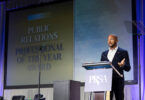It seems appropriate at this time of year to at least acknowledge that those of us who have worked or are working in public relations are blessed with that wond’rous organ known affectionately as the “heart.”
Last time I checked, we all had one, both literally and figuratively, although the latter can be difficult to detect sometimes according to our friends in the media and elsewhere.
Heart, though, is a key element in any successful public relations effort. Without it, messages have a tendency to go unheeded, attitudes to remain unchanged, and programs to fail.
How does this “heart” analogy work?
Effective public relations is a combination of data-driven research (the means through which programs spring to life and are nourished) and emotionally-influenced message development.
Factual, practical analysis helps us get to the root of a problem or opportunity so that we can better craft the messages that help our stakeholders arrive at a better understanding of an action or event affecting them.
But the “message” has to come from the other…the emotional…heart and demonstrate clearly and convincingly that our employer or our client truly does understand and appreciate the impact of that action or event on those stakeholders.
I’m not suggesting that our communications should be tear-drenched rivers of heart-wrenching words. Sometimes straight-and-to-the-point is the best route.
The successful communicator understands the importance of developing a connection with his or her audiences and speaking to them in meaningful ways.
And this is where the second heart comes in. That “heart” senses the emotions of the moment and guides the communicator in selecting words or actions that best convey understanding and empathy.
The message itself addresses a situation in terms that the recipient can understand and (hopefully) accept as valid and viable.
Take heart, and have a heart. A simple maxim to guide us in our efforts to communicate with those who look to us for guidance and information.
“We know the truth, not only by the reason, but by the heart.” – Blaise Pascal, “Pensees” [1670], no. 282







You speak volumes with this post. The additional point here is that the words and action need to be in sync in order for the message to be believed. Thanks agin.
My apologies for the delay in responding, Roger, and you’re right…everything has to be in sync. I really appreciate your reading and commenting!
The heart analogy is a really good way to illustrate the purpose and goal of the public relations professional. I think that conveying the emotion from a company to it’s consumers is a powerful way to not only persuade them to buy product, but see the company more than just a place to waste money.
Thanks very much, Katelyn, and my apologies for the delay in responding. I have always felt that the company that shows its humanity is the company that will succeed. I’ve worked all my professional career…and now teach the same concepts…to “put a face” on my employer, whether it be the US government, a technology company, or a health services provider. Most of the time, I was successful! Thanks so much for reading and responding!
It
seems like whenever I tell people that I am majoring in public
relations they immediately assume that I am going into a very dishonest
“heartless” field. I have never seen the field in that light.
Personally, I never want to be viewed in that way either. This sort of
formula suggested for effective public relations communication makes so
much sense. If we are to convince our target market of something the
best way to do so is through emotion, but there needs to be facts as
well to make the effort seem credible. However, I feel like there could
be a fine line in creating a balance between fact and emotion. Too much
fact and the consumer might feel like we are just throwing out a bunch
of information but too much emotion could make the message not credible.